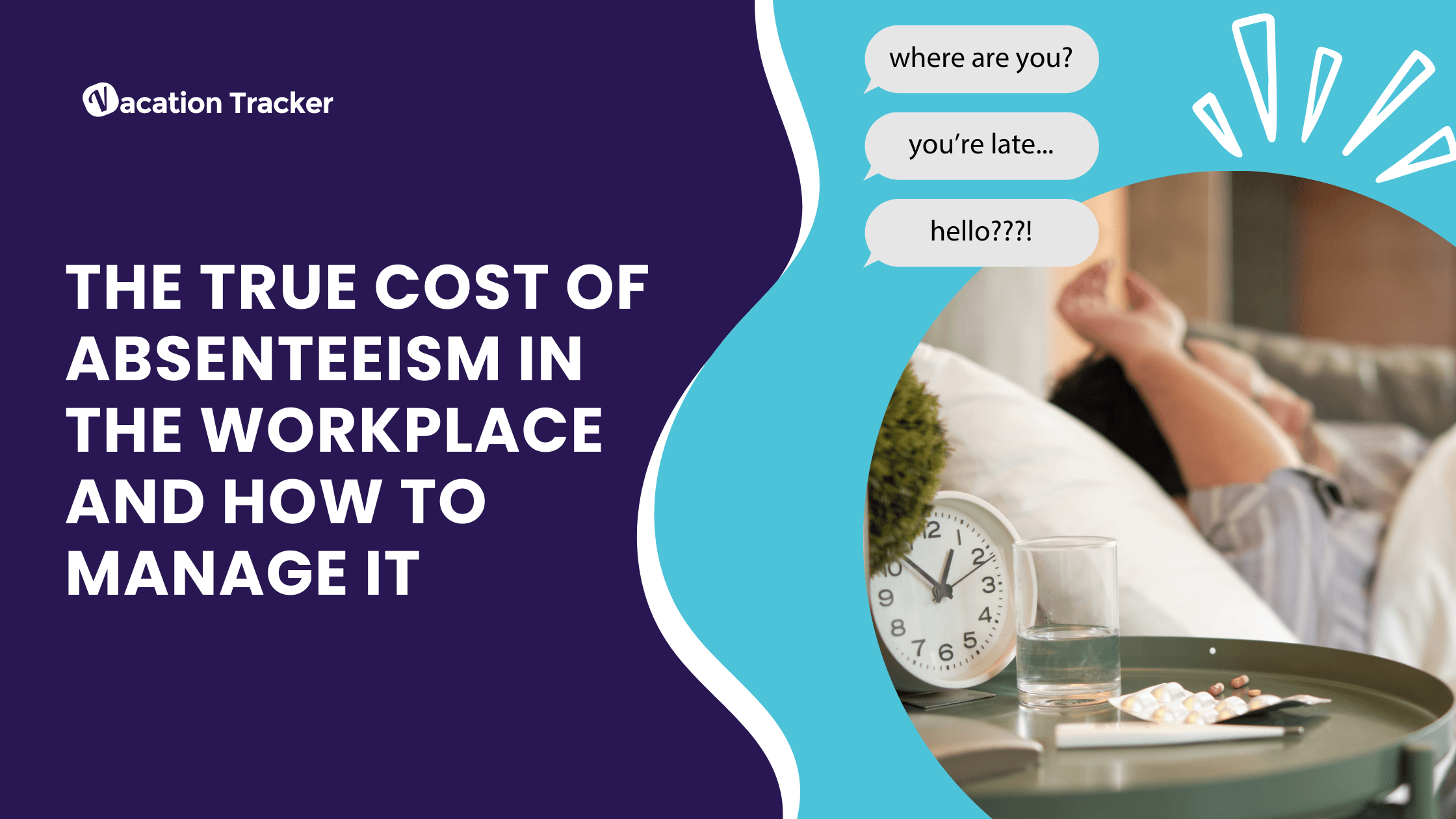The Five Biggest Benefits of Leave Management Systems
Reading Time: 6 minutes
Table Of Contents
The benefits of leave management systems are not lost on any HR department. In fact, a lot of HR departments probably see the benefits. They are just struggling to implement the right solutions for their teams.
Regular employees might not realize that working in an HR department is a balancing act. As a baseline, HR managers must ensure that all their processes are compliant with HR policy and either local or national laws. Then, they must ensure that they are properly staffed to complete the work, while also ensuring that their people take enough vacation days. Finally, they need to make sure that nobody suffers any form of burnout and is relatively happy in their job. It’s a balancing act, indeed!
In fact, leave management is often a time-consuming task. Just approving and managing leaves can be a burden on the HR team.
To automate leave management is to save time. Then why aren’t more organizations implementing leave management solutions? Are they not aware of the potential benefits?
The 10 biggest benefits of leave management systems are listed below. For every benefit, a real-world example is provided. Also, the main obstacle to implementation is highlighted.
Eliminates Paperwork
One of the benefits of leave management systems is that they automate an otherwise demanding process.
Quite often on an HR team, there might be one or more people processing paperwork for leave requests. These are workflows that can require a lot of back-and-forth with team members.
Meanwhile, with a proper leave management system, all of this can be done in just a few clicks. Moreover, an online system is an eco-friendly alternative to traditional employee attendance tracking. As a manager, you can get rid of paperwork by using a leave tracking system or software.
As an added bonus, a move to a paperless solution will instantly boost productivity. By minimizing manual intervention in the leave management process, you are in fact saving time. What’s more, fewer manual interventions mean less human error.
An obstacle to implementation might be the price of putting in place a paperless system. Some systems can in fact be pricy. However, more affordable, startup-friendly software is also available.
Vacation Tracker is a very cost-effective leave management tool. It was built with startups in mind. An organization can even try it out for 7 days without any commitment.
Also, making the move from paperless to a different system may seem complicated. Of course, it can be complicated if a series of files need to be digitized, or if the company policies are complex.
Yet, an organization doesn’t need to search long to find a system that can accommodate even complex leave structures. However, these systems sometimes come with hefty price tags.
Improves Communication Between Employees and Managers
Is asking for leave frowned upon in your organization? Do many employees avoid taking all of their allocated vacation time because they feel stressed about asking for the leave that they are due?
If this sounds like a probable scenario in your organization, then a change is in order. Clear and transparent communications are proven morale boosters. And improved communication is one of the top benefits of leave management systems.
The negative impacts of not communicating clearly can be huge. Employees who skim on leave are much more prone to have burnouts or other health issues.
The improvement in communication can be even more significant for remote team members. It’s not always easy to keep track of attendance and schedules for remote teams. The lack of face-to-face interaction makes it so that vacations or leaves can be even more stressful to ask for and to plan.
An effective leave-tracking software can help managers ensure that proper communication occurs. With the Vacation Tracker app, leave can be requested and approved in seconds. It’s a straightforward and transparent process, that doesn’t require an awkward in-person discussion.
Moreover, notifications can be programmed to ensure that every team member stays in the loop about current or upcoming time off. The Vacation Tracker notifications can be customized to appear on the Slack channel of the administrator’s choice. The frequency of the notifications can also be modified.
A potential obstacle to the implementation to adopt a new system is that communications could end up being spread out across different software. With a Slack integration such as Vacation Tracker, or any other HR integration for Slack, you can keep all of your team communications in one place.
Offers Real-Time Visibility Of Data
Organizations need data to make decisions. The same thing goes for employees. Employees are generally concerned about their benefits. They would like to know that they are getting the benefits they are due. For instance, leave is a crucial employee benefit and needs to be tracked accordingly.
One of the main benefits of leave management systems is that they offer real-time visibility of leave data. It sometimes happens that employees request leave, but do not know whether or not it has been accepted. With a proper system in place, that communication happens seamlessly.
For instance, on the Vacation Tracker Slack integration, employees can simply enter the slash command “/vacation” and click on “My Status” to view all of their leave balances. Requesting leave is just as easy. Approvers or Administrators can approve leaves in a matter of seconds.
Reducing Administrative Burden
Every leave request triggers a series of administrative tasks — from updating records and adjusting schedules to ensuring continuity of work during the employee’s absence. With time off management software, these tasks are automated, freeing up significant time and resources that can be allocated to more strategic initiatives.
Moreover, tech companies often have flexible working arrangements and unique leave policies, adding complexity to leave management. With time off management software, these complexities are easily handled, allowing managers to focus on leading their teams rather than on administrative chores.
Offers a Comprehensive Dashboard
Moreover, Administrators or Approvers have access to the Vacation Tracker Dashboard. This Dashboard congregates all of the upcoming leave information in one place. They can consult this Dashboard at any time or specifically when they need to approve or deny requests.
The upside of having an easy-to-use Employee Attendance Tracking system is that it can be integrated with other systems. In the case of Vacation Tracker, it integrates with Slack, everyone’s favorite team chat tool.
This means that everyone always has access to his or her records, without learning to use an additional complicated HR system. With an easy-to-use Slack integration, data can be accessed on demand, in real-time.
With Vacation Tracker, employees can access data such as their remaining time off, the different types of leave they can request, a history of previous leaves, and more. This can be very time-saving for an HR team as well. They will no longer need to go digging into filing cabinets or through Excel spreadsheets to get this information.
A common obstacle to implementing a leave management system with data available in real-time is once again the cost. However, at 1$ per user per month for its top plan, it really doesn’t get more affordable than Vacation Tracker!
Prevents Pay Errors
Employees, and the millennial workforce, in particular, value transparency in business processes. Being paid correctly and on time is a prime concern for anyone. That goes without saying.
One of the top benefits of leave management systems is that it can prevent human errors. A proper leave management system ensures that no one skips a week of pay when they are taking well-earned paid time off.
A good employee leave tracking software should also simplify the creation of reports. When employee leaves are tracked automatically, it is easier to export employee information for payroll use or for other purposes. It will therefore be easier to make sure that your organization is being compliant with its leave policy.
To ensure legal compliance, an organization’s policy must be properly set up. However, leave management software can indeed help to ensure that the organization follows through with their policy.
With the right reports and the correct information regarding employee leaves, HR will ensure that there are no pay errors. Although it is not the main motivator, pay is still rather important. Which is why preventing errors and ensuring legal compliance are some of the most valuable benefits of leave management systems.
A complex organizational leave policy can be the main obstacle to implementation. Yet, there are many applications or integrations available that can accurately convey policy rules. It’s about finding the right software for your organization. So, it might be normal to try a few before you settle on just one. Luckily, many leave management systems provide free trial offers.
Time Saver
By opting for leave management systems, you save time. One of the major benefits of leave management systems is that they use automation to process data about staff leave, making leave management a faster and seamless process. This frees you up for other important HR tasks that need more of your attention such as long-term strategic planning, employee relations and development, recruitment, and internal team culture.
Centalized Access for the Whole Team
An all-in-one dashboard lets employees view their leave balances and their coworkers’ days off. Managers and HR staff need access to employee leave balances, department schedules, and availability to evaluate leave requests effectively. Most leave tracking software includes a dashboard that keeps all relevant information in one place. They also offer numerous benefits such as end-to-end visibility, better productivity, a team inclusive calendar for improved decision making, easy integration with payroll systems, and more.
Promotes Your Organization’s Values
As previously mentioned, transparency is a great morale booster. Promoting open communication about leave is also a best practice. If transparency and encouraging leave are not yet part of your organization’s values, they definitely should be.
Every HR’s main concern is to keep employees motivated and happy. Therefore, of all the benefits of leave management systems, the main one should be that it promotes your organization’s values.
When scheduling leave is no longer a dreaded 10-day process, but can be done in merely 10 seconds, everybody wins. To implement efficient processes demonstrates to employees that their time is valued. However, it also suggests that time off is important and must be taken.
Hopefully, these five biggest benefits of leave management systems have motivated you to implement one for your organization. Whether it’s to prevent payroll errors, to have access to real-time data, or to make a move to a paperless solution, find the perfect solution for your team.
Choosing the Right Leave Management Software
When choosing the right leave management solution, consider factors such as ease of use, integration capabilities with your existing tools, and the ability to customize leave policies to fit your specific needs.
Look for solutions that offer real-time data visibility, robust reporting features, and support for legal compliance. By investing in the right system, you can streamline processes, reduce errors, and promote a transparent and supportive work environment, ultimately enhancing your organization’s overall productivity and employee morale.
Easy PTO tracking, right at your fingertips.
Automate leave policies, improve visibility and plan better
No credit card required. Instant set-up.

Kristina Ousmanova
Kristina recently left behind fast-paced life of Human Resource Business Consulting to freelance as a Content Writer. A regular Vacation Tracker contributor, she can be found working remotely from her home in Montreal, usually while eating a variety of snacks.



